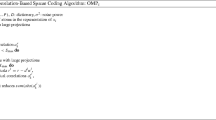Abstract
Orthogonal Matching Pursuit (OMP) is a good candidate for solving energy function optimization problems. In this paper, we propose a novel auxiliary coefficient representation for the problem of image de-fencing. To improve the optimization efficiency of the OMP algorithm, we propose a heuristic form of the OMP (named h-OMP) approximation based on auxiliary coefficient representation. A frequency-domain optimization approach is derived by selecting an over-complete example set for the image signal, the h-OMP algorithm is used to simultaneously remove the fences on the image matrix and find the auxiliary coefficient basis to form the image segment. Experiments show that the proposed h-OMP algorithm generates better output image, whose performance is superior in terms of both subjective and objective evaluation criteria.






Similar content being viewed by others
Notes
The term “fence” here just means physically literal fence, such as shown in Figure 4.
References
Rubinstein R, Bruckstein AM, Elad M (2010) Dictionaries for sparse representation modeling. Proc IEEE 98(6):1045–1057
Huang YZ, Fan N (2011) Inter-frame information transfer via projection onto convex set for video deblurring. IEEE Journal of Selected Topics in Signal Processing 5(2):275–284
Elad M (2010) Sparse and redundant representations: From theory to applications in signal and image processing. Springer, New York
Huang Y, Guan Y (2017) Learning and intelligence can happen everywhere, a case study: learning via non-uniform 1D rulers with applications in image classification and recognition. Multimedia Tools and Applications 76(1):913–929
Bruckstein A, Donoho DL, Elad M (2009) From sparse solutions of systems of equations to sparse modeling of signals and images. SIAM Rev 51(1):34–81
Tropp JA (2004) Greed is good: Algorithmic results for sparse approximation. IEEE Trans Inf Theory 50 (10):2231–2242
Zibulevsky M, Elad M (2010) L 1 L 2 optimization in signal and image processing. IEEE Signal Process Mag 27(3):76–88
Mu Y, Liu W, Yan S (2014) Video de-fencing. IEEE Trans Circts Sys Vid Tech 24:1111–1121
Jonna S, Voleti VS, Sahay RR, Kankanhalli MS (2015) A multimodal approach for image de-fencing and depth inpainting. In: Proceedings of the International Conference on Advances in Pattern Recognition, pp 1–6
Zhao R, Wang Q, Shen Y, Li J (2016) Multiatom tensor orthogonal matching pursuit algorithm for compressive-sensing–based hyper-spectral image reconstruction. J Appl Remote Sens 2016(10):045002
Li W, Zhou Y, Poh N, Zhou F, Liao Q (2013) Feature denoising using joint sparse representation for in-car speech recognition. IEEE Signal Process Lett 20(7):681–684
Gao HY (1998) Wavelet shrinkage denoising using the non-negative garrote. J Comput Graph Stat 7(4):469–488
Donoho DL, Johnstone IM (1994) Ideal spatial adaptation via wavelet shrinkage. Biometrika 81(3):425–455
Donoho DL, Johnstone IM (1995) Adapting to unknown smoothness via wavelet shrinkage. J Am Stat Assoc 90(432):1200–1224
Elad M, Matalon B, Shtok J, Zibulevsky M (2007) A wide-angle view at iterated shrinkage algorithms. In: Proceedings of SPIE (The International Society for Optical Engineering), id. 670102, http://spie.org/Publications/Proceedings/Paper/10.1117/12.741299
Daubechies I (1998) Time-frequency localization operators: a geometric phase space approach. IEEE Trans Inf Theory 34(4):605–612
Mallat SG, Zhang Z (1993) Matching pursuit in a time-frequency dictionary. IEEE Trans Signal Process 41(12):3397–3415
Coifman RR, Wickerhauser MV (1992) Entropy-based algorithms for best-basis selection. IEEE Trans Inf Theory 38(2):713–718
Chen SS, Donoho DL, Saunders MA (2001) Atomic decomposition by basis pursuit. SIAM Rev 43 (1):129–159
Elad M (2006) Why simple shrinkage is still relevant for redundant representations? IEEE Trans Inf Theory 52(12):5559–5569
Zheng Y, Kambhamettu C (2009) Learning based digital matting. In: Proceedings of the International Conference on Computer Vision, pp 889–896
Babaie-Zadeh M, Jutten C (2010) On the stable recovery of the sparsest overcomplete representations in presence of noise. IEEE Trans Signal Process 58(10):5396–5400
Elad M (2002) On the origin of the bilateral filter and ways to improve it. IEEE Trans Image Process 11 (10):1141–1151
Sun W, Yuan Y-X (2006) Optimization theory and methods: Nonlinear programming. Springer, New York
Narkiss G, Zibulevsky M (2005) Sequential subspace optimization method for large-scale unconstrained problems. Technical report CCIT No. 559 Technion, The Israel Institute of Technology, Haifa, https://ie.technion.ac.il/mcib/sesopreportversion301005.pdf
Chen J, Huo X (2006) Theoretical results on sparse representations of multiple-measurement vectors. IEEE Trans Signal Process 54(12):46344643
Wipf DP, Rao BD (2007) An empirical Bayesian strategy for solving the simultaneous sparse approximation problem. IEEE Trans Signal Process 55(7):3704–3716
Luessi M, Babacan SD, Molina R, Katsaggelos AK (2013) Bayesian simultaneous sparse approximation with smooth signals. IEEE Trans Signal Process 61(22):5716–5729
Balkan O, Kreutz-Delgado K, Makeig S (2014) Localization of more sources than sensors via jointly-sparse Bayesian learning. IEEE Signal Process Lett 21(2):131–134
Tropp JA (2006) Algorithms for simultaneous sparse approximation, Part II: Convex relaxation. Signal Process 86(3):589–602
Tropp JA, Gilbert AC, Strauss MJ (2006) Algorithms for simultaneous sparse approximation, Part I: Greedy pursuit. Signal Process 86(3):572–588
Xue T, Rubinstein M, Liu C, Freeman WT (2015) A computational approach for obstruction-free photography. ACM Trans Graph 34:79
Yi R, Wang J (2016) Automatic fence segmentation in videos of dynamic scenes. In: Proceedings of the IEEE Conference on Computer Vision and Pattern Recognition
Park M, Brocklehurst K, Collins R, Liu Y (2009) Deformed lattice detection in real-world images using mean-shift belief propagation. IEEE Trans Pattern Anal Mach Intell 31:1804–1816
Brox T, Malik J (2011) Large displacement optical flow: Descriptor matching in variational motion estimation. IEEE Trans Pattern Anal Mach Intell 33:500–513
Criminisi A, Perez P, Toyama K (2004) Region filling and object removal by exemplar-based image inpainting. IEEE Trans Image Process 13:1200–1212
Huang YZ, Long YJ (2006) Super-resolution using neural networks based on the optimal recovery theory, pp 465–470
Acknowledgments
Funding for this work was supported by the project of Shanghai Universities Young Teacher Training Scheme under Grant No. ZZSB17004.
Author information
Authors and Affiliations
Corresponding author
Rights and permissions
About this article
Cite this article
Li, M. Example-based learning using heuristic orthogonal matching pursuit teaching mechanism with auxiliary coefficient representation for the problem of de-fencing and its affiliated applications. Appl Intell 48, 2884–2893 (2018). https://doi.org/10.1007/s10489-017-1079-9
Published:
Issue Date:
DOI: https://doi.org/10.1007/s10489-017-1079-9




